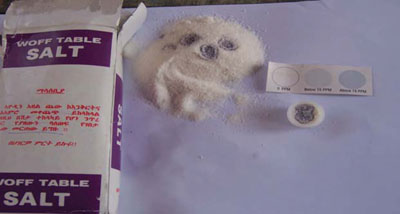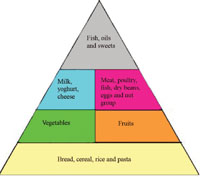5.6 Dietary methods of assessing nutritional status
Dietary methods of assessment include looking at past or current intakes of nutrients from food by individuals or a group to determine their nutritional status. You can ask what the family or the mother and the child have eaten over the past 24 hours and use this data to calculate the dietary diversity score.
Dietary diversity is a measure of the number of food groups consumed over a reference period, usually 24 hours. Generally, there are six food groups that our body needs to have everyday. These can be represented in the food guide pyramid which you read about in Study Session 2 and which is reproduced in Figure 5.14.
You may recall from Study Session 2 the base or widest part of the pyramid indicates the need for higher quantities of consumption of carbohydrate source foods, while the tip is narrow, indicating the need for eating only small amounts of fats and sweet things. If a person consumes any examples of the food type from each of the six groups in 24 hours, we can say that their dietary diversity score is six. Dietary diversity score is an indicator of both the balance of nutrient consumption and the level of food security (or insecurity) in the household. The higher the dietary diversity score in a family, the more diversified and balanced the diet is and the more food-secure the household.
As part of the dietary assessment you should also check the salt iodine level of households using the single solution kit (SSK). This enables you to determine whether the salt iodine level is 0, more than 15 parts per million (PPM) or less than 15 PPM. You can see a photo of an SSK in Figure 5.15. Normally, an iodized salt should have iodine level of more than 15 PPM to be effective in preventing iodine deficiency and its consequences. As a Level IV Health Extension Practitioner you are expected to test the iodine level of household salts twice a year.

You can use the various methods of assessing nutritional status discussed in this study session to evaluate the nutrition status of people living in your community. Whichever measurements you are taking you should remember that it is important to follow procedures correctly and take accurate measurements that ensure the quality of data generated about the individuals you are responsible for in your community.
5.5.4 Visible severe wasting

